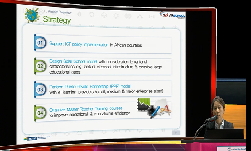Practical Intelligence is a construct which postulates that one aspect of human intelligence involves the capacity to use one's mental and decision making abilities for the purpose of achieving success in a particular context. These abilities are man...
http://chineseinput.net/에서 pinyin(병음)방식으로 중국어를 변환할 수 있습니다.
변환된 중국어를 복사하여 사용하시면 됩니다.
- 中文 을 입력하시려면 zhongwen을 입력하시고 space를누르시면됩니다.
- 北京 을 입력하시려면 beijing을 입력하시고 space를 누르시면 됩니다.
The validity of practical intelligence measures as constructs in the context of academic and vocational programs in high school.
한글로보기https://www.riss.kr/link?id=T10554495
- 저자
-
발행사항
[S.l.]: University of Minnesota 2001
-
학위수여대학
University of Minnesota
-
수여연도
2001
-
작성언어
영어
- 주제어
-
학위
Ph.D.
-
페이지수
211 p.
-
지도교수/심사위원
Adviser: Gary W. Leske.
-
0
상세조회 -
0
다운로드
부가정보
다국어 초록 (Multilingual Abstract)
Practical Intelligence is a construct which postulates that one aspect of human intelligence involves the capacity to use one's mental and decision making abilities for the purpose of achieving success in a particular context. These abilities are manifested in behaviors that take the form of first attempting to adapt to one's environment. If that proves unsuccessful, then attempts to either shape one's environment or select new environments to achieve success are made. One section of the Sternberg Triarchic Ability Test (STAT) claims to measure practical intelligence.
This thesis was directed towards describing this theoretical construct of practical intelligence in the context of high schools, developing a self report instrument designed to measure practical intelligence in this context, and conducting statistical tests to determine the construct validity of the instrument. The purpose was to answer two research questions: How is practical intelligence behavior manifested and observed in high schools? Are the Sternberg Triarchic Ability Test and the high school practical intelligence instrument valid measures of practical intelligence for high school students?.
The methodology was broken into two phases. Phase I attempted to answer the first research question, and involved focus group interviews with high school students to determine how students manifested practical intelligence behaviors in high school environments. From these descriptions a self report instrument, called the Practical Intelligence High School (PIHS), was created. Phase II of the methodology involved a variety of statistical tests to determine empirical relationships between the STAT, the PIHS, and other variables to determine construct validity of practical intelligence of these instruments.
The results document rich descriptions of practical intelligence reported by high school students in terms of adaption, shaping and selecting behaviors used in high school. Also documented are the correlations for the relationships between PIHS and STAT with other variables, including traditional academic intelligence. The findings suggest that the STAT is not a valid measure of practical intelligence and that the adapt and shape aspects of the PIHS may be valid measures of practical intelligence in a high school context.
분석정보
연관 공개강의(KOCW)
-

Education Policy at the Party Conferences
Teachers TV Teachers TV -

2014 이러닝 국제 콘퍼런스 : What is the Lessons from Education Support Project~
한국교육정보진흥협회 Boseon, Kim -

Early Sex Education: The Debate
Teachers TV Teachers TV -

Personal Finance Education: The Money Quiz
Teachers TV Teachers TV -

Further Education: Work Experience
Teachers TV Teachers TV






